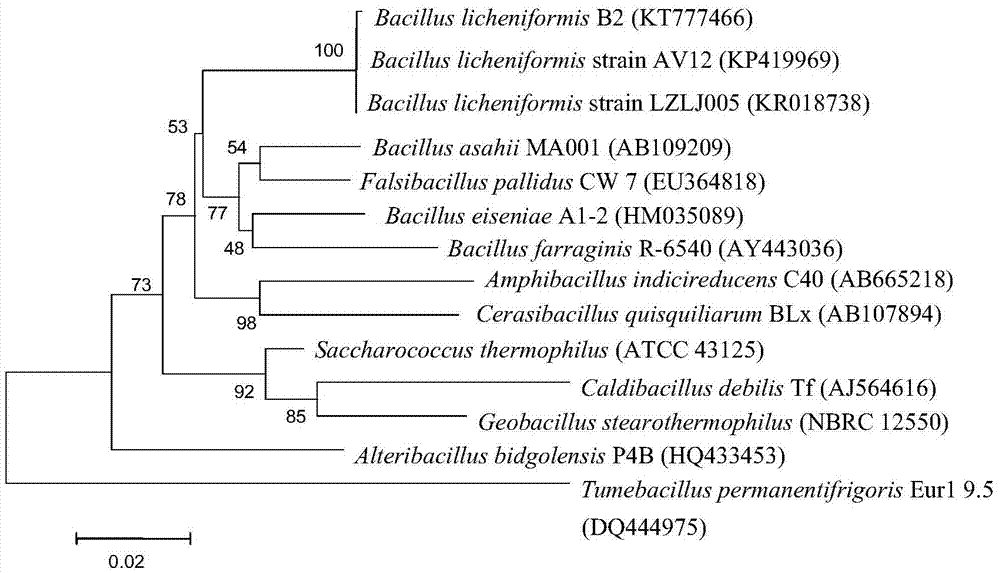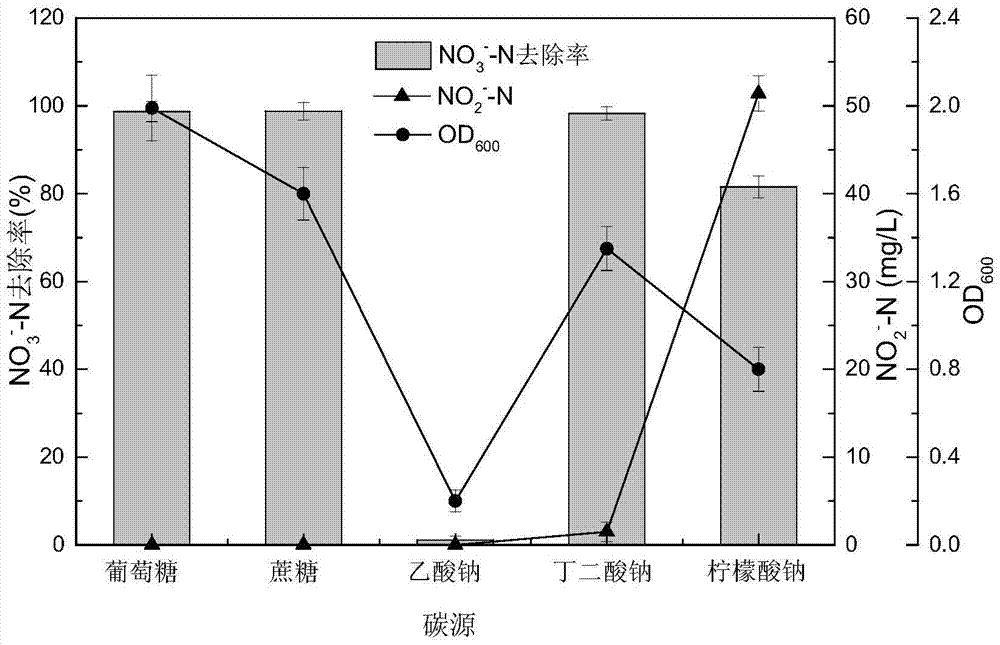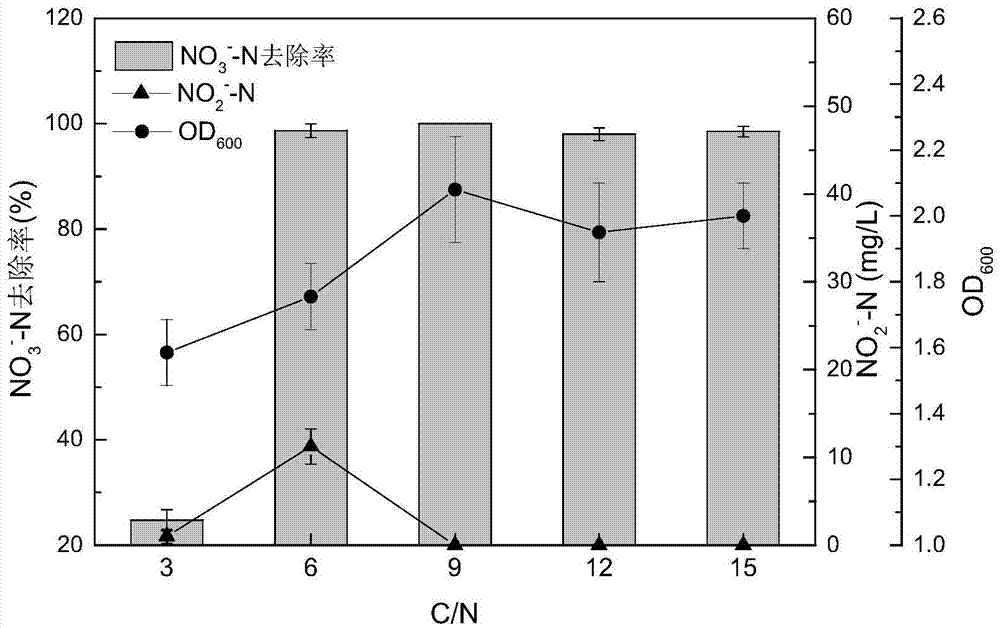Strain of bacillus licheniformis and applications thereof
A Bacillus licheniformis, denitrification technology, applied in the direction of bacteria, nitrous oxide capture, water/sludge/sewage treatment, etc., can solve the problems of being easily affected by temperature fluctuations, and achieve a wide growth temperature range and high efficiency The effect of oxygen denitrification capacity
- Summary
- Abstract
- Description
- Claims
- Application Information
AI Technical Summary
Problems solved by technology
Method used
Image
Examples
Embodiment 1
[0031] Embodiment 1: Isolation, purification and identification of strains
[0032] In this study, the denitrification medium without carbon source was added to the corn leaf hydrolyzate, and the initial temperature was 40°C, and the shaking incubator was 160rpm. After culturing for 24 hours, the inoculum with a volume ratio of 10% was inserted into 90 mL of sterile corn leaf hydrolyzate containing denitrification medium. After repeating the above steps for 3 days, it was found that the bacterial solution grew well, and the denitrification rate reached more than 85%. After the enrichment culture, the bacterial solution was spread on the plate to isolate a single colony by the method of doubling dilution. Take 1 mL of the bacterial solution into a test tube filled with 9 mL of sterile water, mix thoroughly to obtain 10 -1 Gradient bacterial suspension, prepare 10 by analogy -2 ~10 -8 Bacterial suspensions with different gradients, in order to obtain the colony morphology th...
Embodiment 2
[0035] Embodiment 2: Denitrification Performance Determination of Bacillus licheniformis (Bacillus licheniformis) B2
[0036] 1. The denitrification performance of Bacilluslicheniformis B2 under different carbon sources
[0037] The utilization of different carbon sources by strain B2 was investigated, including five carbon sources including glucose, sucrose, sodium acetate, sodium succinate and sodium citrate. The specific operation steps are as follows:
[0038] Inoculate 10mL of bacterial suspension into 90mL of denitrification medium. The composition of denitrification medium is as follows (g / L): KNO 3 1;Na 2 HPO 4 ·7H 2 O0.8; KH 2 PO 4 1.5; MgSO 4 ·7H 2 O0.2; trace element solution 2mL / L; pH7.0. Trace element solution composition (g / L): EDTA50.0; ZnSO 4 2.2; CaCl 2 5.5; MnCl 2 4H 2 O5.06; FeSO 4 ·7H 2 O5.0; (NH 4 ) 6 Mo 7 o 2 4H 2 O1.1; CuSO 4 ·5H 2 O1.57; CoCl 2 ·6H 2 O1. 61. The above five carbon sources were added respectively to make the C / N r...
Embodiment 3
[0052] Embodiment 3: Actual flue gas denitrification experiment of Bacillus licheniformis (Bacillus licheniformis) B2
[0053] Removal of NO in High Temperature Environment Using Biological Trickling Filter x experiment of. biofiltration systems such as Figure 7 As shown, air inlet 1, atomizer humidifier 2, temperature controller 3, biological trickling filter tower 4, constant temperature water bath 5, mass flow meter 6, and gas outlet 7. The nutrient composition in the liquid storage tank during the film-forming period of the biofilter is the same as in Example 2, and the stability of the system under the condition of actual flue gas fluctuations is investigated.
[0054] The flue gas flow rate is 1L min -1 , the residence time is 1min. To keep B2 dominant at all times, replace two-thirds of the nutrient solution containing 10% fresh B2 every three days. The removal efficiency of nitrate increased gradually, and after reaching 80%, the concentration of nitrate in the n...
PUM
 Login to View More
Login to View More Abstract
Description
Claims
Application Information
 Login to View More
Login to View More - Generate Ideas
- Intellectual Property
- Life Sciences
- Materials
- Tech Scout
- Unparalleled Data Quality
- Higher Quality Content
- 60% Fewer Hallucinations
Browse by: Latest US Patents, China's latest patents, Technical Efficacy Thesaurus, Application Domain, Technology Topic, Popular Technical Reports.
© 2025 PatSnap. All rights reserved.Legal|Privacy policy|Modern Slavery Act Transparency Statement|Sitemap|About US| Contact US: help@patsnap.com



